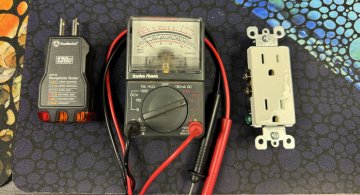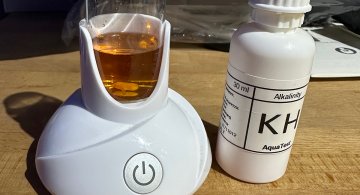Manually helping each zoanthid polyp heal up
I'm really enjoying the fact that Peaches is always out when I glance at the 55g reef. Her bright orange color is striking, and the hot pink dorsal fin pops up often enough to see its vividness. Tucker, my Hippo Tang, is not quite a long as the Anthias, but seems to want to control her or at least keep her away from the food. Peaches holds her own quite nicely, at least for now.
I'm feeding the tank quite often so that she'll be less shy, because I've noticed when I hover too long over the tank she disappears into the rockwork. I'd prefer it if she thought I always bringing food, only so I can continue to view her up close. ;)
Interestingly, the 55g reef is growing much more algae on the glass panes compared to the 29g. I'm guessing the extra food is fueling the growth, but perhaps it is part of the current Spring cycle. The food never lasts longer than 90 seconds. Nutrients do fuel algae growth, especially when excessive.
The BTA split a couple of days ago (two clones and the original) finally, and the large section that remained looks like it is not going to split. I was pretty sure I was going to end up with 4 tiny ones the way things were progressing. Two babies and a larger one is just fine with me. The larger one is pulling itself together so that it looks more normal, after a month of it being stretched across the rockwork. It has grown a lot of new pretty tentacles. I have not been target feeding the BTAs at all, but I think I should as the smaller ones look like they need it.
I was given a couple of frags yesterday of some bright green caulastrea, so I put one piece in each tank.
The zoanthids that were in trouble are not healthy, but a number of polyps have opened up. I noticed that when they begin to wither away, the top of the polyp is constricted and hardened. Last week I took a turkey baster to blow off the colony with short bursts of streaming water, and also use the baster to suck the top of each polyp slightly. In some cases, the harded 'cap' came loose, hinging back off the top of the polyp. A couple came off completely. What occured next is that some of the polyps were able to open up slightly to breathe, so to speak. One formed a new head even as the hinged cap was still attached but slightly out of the way. I'm pretty sure this is an infection of some sort, and removing that cap seems to allow the polyp to recover. I may even try pulling it out of the tank to carefully trim off the top of the polyps in trouble, using an X-acto knife (razor knife).
Btw, if you are wondering how I came up with Tucker as the name for the Blue Tang, it is because he continues to tuck himself into bed in my Milleopora to sleep each night. As he grows, he'll lose this cozy spot that he's used since he was 1" long. He's looking very healthy and almost fat, and a fat tang is a happy one in my book.















